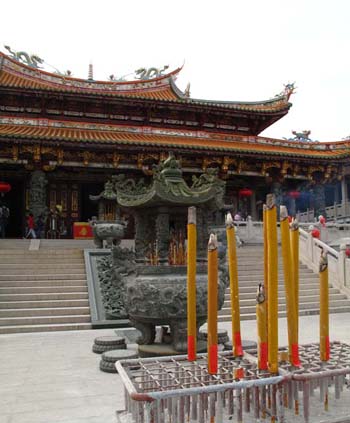
 Another Macao to go
Another Macao to go
By Michelle, Ho Hoi Kei
It is nine o'clock on a Sunday morning, and I should be sleeping in bed at this moment, but instead, I am now driving along the Cotai Strip. Looking up the beautiful sky and bursting out, "What a nice day!" It is a wonderful day to go site visiting. My destination is the outstanding white statue on the peak of the Alto in Coloane, the A-Ma Cultural Village. I am heading to discover the other side of Macao, to view Macao in another way.
Arriving at the ruins of the cultural village at the foot of the hill, instead of continuing driving, I choose to take the shuttle bus, so I can enjoy the scenery along the way up to the village. There are already some people on the bus. Some of them are tourists. I am the last one to get on. Going through the green, buildings and cars become smaller and smaller. With the beautiful sunshine, Macao looks bright. It seems that I am leaving Macao and reaching to another world. And I arrive at the A-Ma Cultural Village.
Away from casinos, away from residents, away from rush hour traffic and polluted air, the A-Ma Cultural Village is located on Coloane Alto, opposite to the Peak Park. The village is about 7,000 m2 large. It was built in the year 2001, as an axis of developing a large religious cultural tourism area. The majestic white A-Ma statue is situated on the top of the Alto, the highest point of Coloane,W which is 172 metres above sea level. In this way, people can see the statue from every part of the island.
Passing through the main ruins is a big fishpond, and a few shops are by the side. The place is quiet with few visitors. In front is the Tian Hou Palace (Tian Hou is another name for A-Ma), it is of a Qing Dynasty-style construction, red walls and green tiles, decorated with resplendent and magnificent details, and exquisite sculptures. The two stone lions' responsibilities are to guard the palace. There are also bell towers, a temple palace and a museum in the village.
The gigantic white A-Ma statue is just a short distance from the village. On the highest point of Macao, A-Ma is looking at and protecting Macao. A-Ma, the Goddess of Sea, is known as the one who looks after Macao according to the history. Years ago, Macao was a small village. Most people earned their living by fishing. In hoping for a safe journey, people started worshiping A-Ma.
Opposite the village is the Peak Park. From there, people can have an overview of Macao. I am happy with the good weather today, letting me smell and feel Macao in a different way.
"The atmosphere here is more of quiet and solemn, which helps soothe oneself," Joan, a visitor from Hong Kong said. Joan came to Macao for a two-day trip with her parents. "We come here as my parents like visiting temples and I like taking photos. The village is really a good place for photos." Joan added that her parents love the place.
The A-Ma Cultural Village is away from the busy and colorful city; instead, it is situated in a peaceful and simple hill. Shopkeepers said that there were some locals who come up regularly, to pray and help in the village. Others are usually
tourists.
Living in Macao, many locals have never been to the A-Ma Cultural Village. So, give yourself one day's time, leave the neon-lighted city, leave your busy work, away from the heavy traffic, and discover another Macao -- the natural and simple Macao.